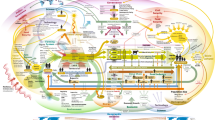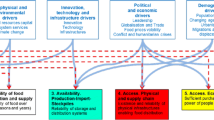Abstract
The security of the US food supply faces unprecedented challenges due to changes in our food system and the environment during recent decades. The 27 articles in the Symposium on American Food Resilience examine the resilience of food production and distribution – the system’s ability to withstand shocks or stresses that could lead to disruption of the food supply. Four central questions provide a framework:
-
1.
What are the main lines of vulnerability and how do they function?
-
2.
What are leverage points for reducing the risks and improving the capacity to cope with breakdowns?
-
3.
What is already being done by government, civil society, and the private sector?
-
4.
What can scientists, teachers, and other professionals do through research, education, community action, or other means to make the food system more resilient?
The Symposium is in two parts. Part 1, which was published in the last issue of this Journal, laid out a conceptual framework and surveyed the problems. Part 2, which is in this issue, focuses on solutions. Paradigm shift is a major theme in Part 2. It revolves around two key ingredients:
-
1.
Conflict between the prevailing “industrial” paradigm and sustainability
-
2.
The scale of food system operations, and the contribution that more resilient regional food systems can make to the security of our food supply
Concrete details are provided by case studies from New England, Ohio, North and South Carolina, and Wisconsin, where researchers or nonprofit organizations have collaborated with food system practitioners to strengthen and diversify regional food production and food supply chains. A case study from Washington applies the diversity perspective to a strategic analysis of regional capacity for disaster response. Resilience planning in Australia features strategic policy analysis with quantitative techniques such as linear programming optimization and system dynamics, which can profitably be employed elsewhere as well. Together, the Symposium articles provide a bounty of material that can be mined by researchers, teachers, policy makers, farmers, and other food system practitioners for application to their own circumstances.
Similar content being viewed by others
References
Anderson MD (2015) The role of knowledge in building food security resilience across food system domains. J Environ Stud Sci. doi:10.1007/s13412-015-0311-3
Atalan-Helicke N (2015) Seed exchange networks and food system resilience in the United States. J Environ Stud Sci. doi:10.1007/s13412-015-0346-5
Belyakov A (2015) From Chernobyl to Fukushima: an interdisciplinary framework for managing and communicating food security risks after nuclear plant accidents. J Environ Stud Sci 5:404–417. doi:10.1007/s13412-015-0284-2
Candy S, Biggs C, Larsen K, Turner K (2015) Modeling food system resilience: a scenario-based simulation modelling approach to explore future shocks and adaptations in the Australian food system. J Environ Stud Sci. doi:10.1007/s13412-015-0338-5
Dunning R, Bloom JD, Creamer N (2015) The local food movement, public-private partnerships, and food system resiliency. J Environ Stud Sci. doi:10.1007/s13412-015-0295-z
Dyball R (2015) From industrial production to biosensitivity: the need for a food system paradigm shift. J Environ Stud Sci. doi:10.1007/445s13412-015-0323-z
Fraser EDG, Legwegoh A, Krishna KC (2015) Food stocks and grain reserves: evaluating whether storing food creates resilient food systems.. J Environ Stud Sci 5:445–458. doi:10.1007/s13412-015-0276-2
Hendrickson MK (2015) Resilience in a concentrated and consolidated food system. J Environ Stud Sci 5:418–431. doi:10.1007/s13412-015-0292-2
Hodbod J, Eakin H (2015) Adapting a social-ecological resilience framework for food systems. J Environ Stud Sci 5:474–484. doi:10.1007/s13412-015-0280-6
Hoy CW (2015) Agroecosystem health, agroecosystem resilience, and food security. J Environ Stud Sci. doi:10.1007/s13412-015-0322-0
Huff AG, Beyeler WE, Kelley NS, McNitt JA (2015) How resilient is the United States food supply to pandemics? J Environ Stud Sci 5:337–347. doi:10.1007/s13412-015-0275-3
Jacques PJ (2015) Civil society, corporate power, and food security: counter-revolutionary efforts that limit social change. J Environ Stud Sci 5:432–444. doi:10.1007/s13412-015-0294-0
Keppen D, Dutcher P (2015) The 2014 drought and water management policy impacts on California’s Central Valley food production. J Environ Stud Sci 5:362–377. doi:10.1007/s13412-015-0283-3
Lengnick L (2015) Vulnerability of the US food system to climate change. J Environ Stud Sci 5:348–361. doi:10.1007/s13412-015-0290-4
Lengnick L, Miller M, Marten GG (2015) Metropolitan foodsheds: a resilient response to the climate change challenge? J Environ Stud Sci. doi:10.1007/s13412-015-0349-2
MacFall J, Lelekacs JM, LeVasseur T, Moore S, Walker J (2015) Toward resilient food systems through increased agricultural diversity and local sourcing in the Carolinas. J Environ Stud Sci. doi:10.1007/s13412-015-0321-1
MacMahon A, Smith K, Lawrence G (2015) Connecting resilience, food security and climate change: lessons from flooding in Queensland, Australia. J Environ Stud Sci 5:378–391. doi:10.1007/s13412-015-0278-0
Maltz A (2015) “Plant a victory garden: our food is fighting”: lessons of food resilience from world war. J Environ Stud Sci 5:392–403. doi:10.1007/s13412-015-0293-1
Marten GG, Atalan-Helicke N (2015) Introduction to the symposium on American food resilience. J Environ Stud Sci 5:308–320. doi:10.1007/s13412-015-0310-4
Miller M, Solin J (2015) The power of story for adaptive response—marshaling individual and collective initiative to create more resilient and sustainable food systems. J Environ Stud Sci. doi:10.1007/s13412-015-0332-y
Paci-Green R, Berardi G (2015) Do global food systems have an Achilles heel? The potential for regional food systems to support resilience in regional disasters. J Environ Stud Sci. doi:10.1007/s13412-015-0342-9
Rotz S, Fraser EDG (2015) Resilience and the industrial food system: analyzing the impacts of agricultural industrialization on food system vulnerability. J Environ Stud Sci 5:459–473. doi:10.1007/s13412-015-0277-1
Ruhf KZ (2015) Regionalism: a New England recipe for a resilient food system. J Environ Stud Sci. doi:10.1007/s13412-015-0324-y
Stave KA, Kopainsky B (2015) A system dynamics approach for examining mechanisms and pathways of food supply vulnerability. J Environ Stud Sci 5:321–336. doi:10.1007/s13412-015-0289-x
Tolley B, Gregory R, Marten GG (2015) Promoting resilience in a regional seafood system: New England and the Fish Locally Collaborative. J Environ Stud Sci. doi:10.1007/s13412-015-0343-8
Ward JD (2015) Can urban agriculture usefully improve food resilience? Insights from a linear programming approach. J Environ Stud Sci. doi:10.1007/s13412-015-0306-0
Author information
Authors and Affiliations
Corresponding author
Additional information
Gerald G. Marten is editor, and Nurcan Atalan-Helicke is coeditor, of the Journal of Environmental Studies and Sciences’ Symposium on American Food Resilience.
Rights and permissions
About this article
Cite this article
Marten, G.G., Atalan-Helicke, N. Introduction to the Symposium on American Food Resilience (Part 2). J Environ Stud Sci 5, 537–542 (2015). https://doi.org/10.1007/s13412-015-0348-3
Published:
Issue Date:
DOI: https://doi.org/10.1007/s13412-015-0348-3




